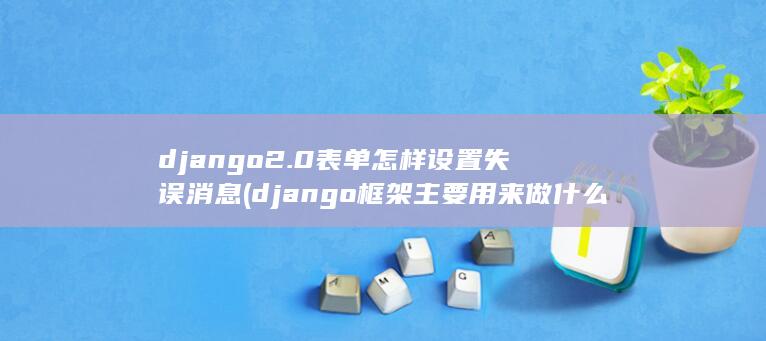本文目录导航:
django2.0表单怎样设置失误消息?
导读:很多好友问到对于django2.0表单怎样设置失误消息的相关疑问,本文首席CTO笔记就来为大家做个具体解答,供大家参考,宿愿对大家有所协助!一同来看看吧!
djangoformerror修正样式可以去csdn找下,csdn的博客也可以找,下载那可以找相关资料找找
网站:
下载注册个账号就能下载
博客
django2.0外键处置
Django2.0里model外键和一对一的on_delete参数
在django2.0后,定义外键和一对一相关的时刻须要加on_delete选项,此参数为了防止两个表里的数据不分歧疑问,不然会报错:
TypeError:__init__()missing1requiredpositionalargument:on_delete
举例说明:
user=(User)
owner=(UserProfile)
须要改成:
user=(User,on_delete=)?????--在老版本这个参数()是自动值
owner=(UserProfile,on_delete=)???--在老版本这个参数()是自动值
参数说明:
on_delete有CASCADE、PROTECT、SET_NULL、SET_DEFAULT、SET()五个可选用的值
CASCADE:此值设置,是级联删除。
PROTECT:此值设置,是会报完整性失误。
SET_NULL:此值设置,会把外键设置为null,前提是准许为null。
SET_DEFAULT:此值设置,会把设置为外键的自动值。
SET():此值设置,会调用外面的值,可以是一个函数。
普通状况下经常使用CASCADE就可以了。
上方是官网文档说明:
ForeignKeyacceptsotherargumentsthatdefinethedetailsofhowtherelationworks.
WhenanobjectreferencedbyaForeignKeyisdeleted,DjangowillemulatethebehavioroftheSQLconstraintspecifiedbytheon_,ifyouhaveanullableForeignKeyandyouwantittobesetnullwhenthereferencedobjectisdeleted:
user=(User,_NULL,blank=True,null=True,)
Deprecatedsinceversion1.9:on_.
Thepossiblevaluesforon_:
CASCADE[source]?
PROTECT[source]?
PreventdeletionofthereferencedobjectbyraisingProtectedError,.
SET_NULL[source]?
SettheForeignKeynull;thisisonlypossibleifnullisTrue.
SET_DEFAULT[source]?
SettheForeignKeytoitsdefaultvalue;adefaultfortheForeignKeymustbeset.
SET()[source]?

SettheForeignKeytothevaluepassedtoSET(),orifacallableispassedin,,:
_user__sentinel_user():returnget_user_model()_or_create(username=deleted)[0]classMyModel():user=(_USER_MODEL,on_delete=(get_sentinel_user),)
DO_NOTHING[source]?
,thiswillcauseanIntegrityErrorunlessyoumanuallyaddanSQLONDELETEconstrainttothedatabasefield.
_choices_to?
SetsalimittotheavailablechoicesforthisfieldwhenthisfieldisrenderedusingaModelFormortheadmin(bydefault,allobjectsinthequerysetareavailabletochoose),aQobject,oracallablereturningadictionaryorQobjectcanbeused.
Forexample:
staff_member=(User,on_delete=,limit_choices_to={is_staff:True},)
causesthecorrespondingfieldontheModelFormtolistonlyUsersthathaveis_staff=.
Thecallableformcanbehelpful,forinstance,:
deflimit_pub_date_choices():return{pub_date__()}limit_choices_to=limit_pub_date_choices
Iflimit_choices_toisorreturnsaQobject,whichisusefulforcomplexqueries,thenitwillonlyhaveaneffectonthechoicesavailableintheadminwhenthefieldisnotlistedinraw_id_fieldsintheModelAdminforthemodel.
Ifacallableisusedforlimit_choices_to,,,sothereisapossibilityyourcallablemaybeinvokedseveraltimes.
如何自定义django中自定义表单的失误消息你先把template在这个字段的代码贴一下KissMyDumbAss
{{_text}}就这个
django失掉表单页面复选框的值报错class?AddBookForm():
????def?__init__(self,*args,**kwargs):
????????[authors]?=?[(,_name?+???+?_name)?for?author?in?()]
????????[publisher]?=?[(,-----------)]?+?[(,)?for?publisher?in?()]
form里这两行有疑问,这行假设你想从新赋值的话应该给一个queryset,而不是列表。
假设你想测试一下的话可以先把这行注释掉,而后你在提交看看表单验证能否能经过。
假设经过了那确定疑问就是这里了。
我想我应该不会错。
。
。
django的文档
Django1.0 建设了弱小完整的文档体系,,涵盖了Django的方方面面,并且适宜各种水平的读者和开发者. 其中还蕴含若干个便捷的示例,你可以追随他们一步步体验Django的柔美。
截至目前,Django最新版本是1.7.7,1.7系列版本的文档十分的片面,关键由以下几局部组成:First steps,提供一个极速起步的教程,可以很快开局经常使用DjangoThe model layer,引见Django的形象模型层The view layer,引见Django的视图层The template layer,引见Django的模板层Forms,引见Django提供的一系列用于协助经常使用表单的工具The development process,引见Django提供的一系列用于开发和测试的工具The admin,引见Django提供的用于站点、内容治理的工具Security,引见Django提供的用于站点安保控制的工具Internationalization and localization,引见Django提供的用于世界化和本地化的工具Performance and optimization,引见Django提供的用于功能和提升的方面的工具以及倡导Python compatibility,引见Django在不同Python环境下的兼容性(Jython和Python 3)Geographic framework,引见Django提供的天文位置相关的工具Common web application tools,引见Django提供的一些罕用的Web运行程序工具(比如RSS等)Other core functionalities,引见Django提供的其它关键工具(比如跳转、路由等等)The django open source project,引见Django作为开源名目标一些内容,比如设计哲学,如何介入开发等等。
django如何给外键赋值(2023年最新整顿)
django如何设置外键先给data赋值了之后,再去用p保留。例如:
data=Lessonruntime()
data.***=***#(给data的列赋值)
()#保留data(注,只要在新建data数据时才要,否则用()来失掉data的值)
p=Checkinlog(lessonruntimeid=data)
这样就可以了。
无法以用p=Checkinlog(lessonruntimeid=1134)的模式启动赋值。
django2.0外键处置Django2.0里model外键和一对一的on_delete参数
在django2.0后,定义外键和一对一相关的时刻须要加on_delete选项,此参数为了防止两个表里的数据不分歧疑问,不然会报错:
TypeError:__init__()missing1requiredpositionalargument:on_delete
举例说明:
user=(User)
owner=(UserProfile)
须要改成:
user=(User,on_delete=)?????--在老版本这个参数()是自动值
owner=(UserProfile,on_delete=)???--在老版本这个参数()是自动值
参数说明:
on_delete有CASCADE、PROTECT、SET_NULL、SET_DEFAULT、SET()五个可选用的值
CASCADE:此值设置,是级联删除。
PROTECT:此值设置,是会报完整性失误。
SET_NULL:此值设置,会把外键设置为null,前提是准许为null。
SET_DEFAULT:此值设置,会把设置为外键的自动值。
SET():此值设置,会调用外面的值,可以是一个函数。
普通状况下经常使用CASCADE就可以了。
上方是官网文档说明:
ForeignKeyacceptsotherargumentsthatdefinethedetailsofhowtherelationworks.
WhenanobjectreferencedbyaForeignKeyisdeleted,DjangowillemulatethebehavioroftheSQLconstraintspecifiedbytheon_,ifyouhaveanullableForeignKeyandyouwantittobesetnullwhenthereferencedobjectisdeleted:
user=(User,_NULL,blank=True,null=True,)
Deprecatedsinceversion1.9:on_.
Thepossiblevaluesforon_:
CASCADE[source]?
PROTECT[source]?
PreventdeletionofthereferencedobjectbyraisingProtectedError,.
SET_NULL[source]?
SettheForeignKeynull;thisisonlypossibleifnullisTrue.
SET_DEFAULT[source]?
SettheForeignKeytoitsdefaultvalue;adefaultfortheForeignKeymustbeset.
SET()[source]?
SettheForeignKeytothevaluepassedtoSET(),orifacallableispassedin,,:
_user__sentinel_user():returnget_user_model()_or_create(username=deleted)[0]classMyModel():user=(_USER_MODEL,on_delete=(get_sentinel_user),)
DO_NOTHING[source]?
,thiswillcauseanIntegrityErrorunlessyoumanuallyaddanSQLONDELETEconstrainttothedatabasefield.
_choices_to?
SetsalimittotheavailablechoicesforthisfieldwhenthisfieldisrenderedusingaModelFormortheadmin(bydefault,allobjectsinthequerysetareavailabletochoose),aQobject,oracallablereturningadictionaryorQobjectcanbeused.
Forexample:
staff_member=(User,on_delete=,limit_choices_to={is_staff:True},)
causesthecorrespondingfieldontheModelFormtolistonlyUsersthathaveis_staff=.
Thecallableformcanbehelpful,forinstance,:
deflimit_pub_date_choices():return{pub_date__()}limit_choices_to=limit_pub_date_choices
Iflimit_choices_toisorreturnsaQobject,whichisusefulforcomplexqueries,thenitwillonlyhaveaneffectonthechoicesavailableintheadminwhenthefieldisnotlistedinraw_id_fieldsintheModelAdminforthemodel.
Ifacallableisusedforlimit_choices_to,,,sothereisapossibilityyourcallablemaybeinvokedseveraltimes.
如何在DJANGO里,向有外键的DB里拔出数据
普通数据项:间接拔出
外键数据项:先失掉要拔出的外键,而后和普通想一同拔出
多对少数据项:失掉要拔出的多对少数据项,待表中普通数据项和外键数据项save后,经常使用方法添加
PS,假设判别降级还是拔出呢?
obj,created=_or_create(
printobj,created
Django中,如何为ForeignKey设置自动值最迷信须要用一个外键的表的特定一个值来给创立的对象的某个字段设置自动值,想到如下前两种方法,看到前面一种,都觉得不太迷信。
default_what=(name=default)
nation=(Country,default=IT)
DEFAULT_ID=1
what=(Country,default=DEFAULT_ID)
classCountryManager():
defget_by_natural_key(self,sigla):
(sigla=sigla)
classCountry():
objects=CountryManager()
sigla=(max_length=5,unique=True)
def__unicode__(self):
returnu%s%
classCity():
nome=(max_length=64,unique=True)
nation=(Country,default=IT)
[some_field_name]====请选用选项===
假设我了解错了,请完善一下你的疑问。
结语:以上就是首席CTO笔记为大家引见的对于django如何给外键赋值的所有内容了,宿愿对大家有所协助,假设你还想了解更多这方面的消息,记得收藏关注本站。

